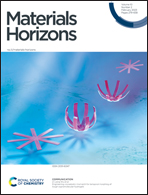Relating reorganization energies, exciton diffusion length and non-radiative recombination to the room temperature UV-vis absorption spectra of NF-SMA†
Abstract
Understanding excited-state reorganization energies, exciton diffusion lengths and non-radiative (NR) recombination, and the overall optoelectronic responses of nonfullerene small molecule acceptors (NF-SMAs) is important in order to rationally design new materials with controlled properties. While the effects of structural modifications on the optical gaps and electron affinities of NF-SMAs have been studied extensively, analyses of their absorption spectra that carefully characterize electronic and vibrational contributions that allow comparisons of reorganization energies and their implications for exciton diffusion lengths and NR recombination have yet to be reported. Here, we study the room temperature absorption spectra of three structural classes of NF-SMAs in dilute solutions through multiparameter Franck Condon (MFC) analyses and density functional theory (DFT) calculations. We show that the absorption spectra of these NF-SMAs can be categorized based on molecular structure–spectra correlation. The absorption spectra of curved, Y6-like structures can be described using an MFC model with two electronic transitions and two effective vibrational modes. The results of MFC/DFT analyses reveal that Y6 exhibits the smallest intra-molecular reorganization energy among the materials studied. Linear ITIC-like molecular structures reveal larger reorganization energies and reduced conformational uniformity compared to Y6. Meanwhile structures such as IDTBR and IEICO, which have an extra π-conjugated moiety between the donor and acceptor moieties, have large excited-state reorganization energies and low degrees of conformational uniformity. Since the intra-molecular reorganization energy is correlated with exciton diffusion length and nonradiative voltage losses (ΔVnr), our results highlight the power of RT absorption spectroscopy and DFT calculations as simple tools to designing improved OSCs materials with small reorganization energies, small ΔVnr, large exciton diffusion length and low energetic disorder (due to a strongly dominant conformation).



 Please wait while we load your content...
Please wait while we load your content...
